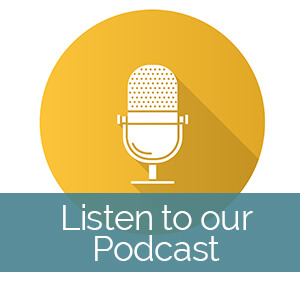In this story of tragedy and strong family bonds, a sister-in-law becomes the gestational carrier for her brother and his wife
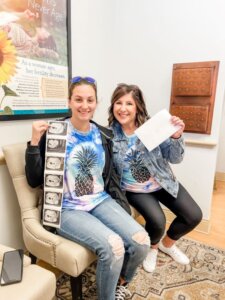
As sisters-in-law, Stephanie and Darra have a unique bond like no other. Their bond will last a lifetime and is probably even stronger than that of real sisters. And at the center of that bond is a beautiful little girl named Ruby.
What makes their bond so strong is the fact that Darra gave birth to Stephanie’s daughter Ruby. When Stephanie was facing a possible future without a biological child after the devastating outcomes of her two prior pregnancies and then a cancer diagnosis, Darra stepped up. She unselfishly volunteered to be her gestational carrier.
Two pregnancies with devastating outcomes
Stephanie and her husband Drew didn’t have trouble conceiving for both her pregnancies. That part came easy. But both pregnancies ended tragically in postnatal death from two completely unrelated circumstances.
In 2019, Stephanie’s first pregnancy ended in tragedy due to HELLP syndrome. HELLP stands for Hemolysis, Elevated Liver enzymes and Low Platelets. This syndrome is a life-threatening pregnancy complication and a variant of preeclampsia that usually occurs during the later stages of pregnancy or soon after childbirth.
At 27 weeks pregnant Stephanie was rushed to the hospital with severe abdominal pain. Once there, the hospital staff recognized her condition and rushed her into an emergency C-section. Her baby boy, Dash, born so prematurely and weighing just a pound and a half with underdeveloped lungs, lived only 9 days.
A year later in July 2020, in the midst of the COVID-19 pandemic, Stephanie was again pregnant. But at 32 weeks she began feeling acute abdominal pain due to a uterine abruption, a risk of the C-section she had with Dash’s birth. At the hospital, though, Stephanie was shuttled instead into an isolation room because she had tested positive for COVID eleven days before. There she waited for the next 18 hours.
By the time Stephanie was wheeled in for a C-section, her belly was full of blood from the abruption and the umbilical cord had been wrapped around her baby’s neck. Briggs, deprived of oxygen and hypoxic, had severe brain damage and would live only 7 weeks.
Then, on her first visit to her obstetrician following the loss of Briggs, Stephanie was diagnosed with early stage cervical cancer. With this diagnosis and the damage to her uterus from the abruption, her doctor told her she would not be able to safely carry another pregnancy. She advised her to have a hysterectomy.
At this point, Stephanie and Drew were devastated. “All Drew and I wanted was to take a baby home from the hospital,” says Stephanie. “We really couldn’t believe all this was happening to us.”
Making good on a promise
The Lake Charles couple considered adoption, but they longed to have a biological child of their own. Without a uterus, though, her options would be limited. But there was a way to have a baby if someone else carried it. She would need a gestational carrier.
Drew’s sister Darra had offered to carry a baby for them after they lost Dash in 2019. At the time, the couple received it as a really nice gesture from a concerned relative during a time of crisis. But was she really serious? “At this crossroads in our journey, I needed to know how serious she was about her offer,” remembered Stephanie. “Drew and I really wanted to have a baby, and there was no way I would ever be able to carry another pregnancy after a hysterectomy.”
To Stephanie’s relief, Darra was intent on honoring her offer. Divorced with two grade school-aged children, Darra wanted to do whatever she could to help her brother and sister-in-law and if that meant becoming their gestational carrier, she would do it. “I hadn’t been pregnant in 10 years and had had my tubes tied,” says Darra. “But I was determined to help them bring a baby home from the hospital.”
Hoops to jump through to make it happen
With Darra on board, and the hysterectomy on hold until they could create some embryos, Stephanie and Drew began the process of having a baby through a gestational carrier. This process follows the same steps as an in vitro fertilization cycle: ovarian stimulation, egg retrieval, fertilization in the IVF lab to create embryos, and then an embryo transfer. The only difference is that the embryo would be transferred to Darra instead of Stephanie.
After meeting with Dr. John Storment of Fertility Answers in Lafayette, he advised the couple a baby could be possible with Darra as their gestational carrier, but there were lots of hoops to jump through. First, they would need to do an egg retrieval on Stephanie and then test the fertilized embryos using preimplantation genetic testing in hopes of having a normal embryo. Since Stephanie was in her late 30s, her age would decrease her chances of producing good eggs and embryos.
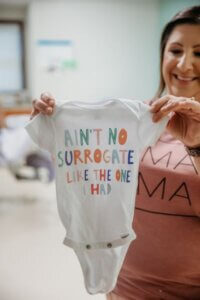
Second, Louisiana has some of the most stringent laws surrounding surrogacy and gestational carriers. A lawyer specializing in reproductive law would need to be involved. Legal contracts would need to be drawn up. The couple would not initially be listed on their baby’s birth certificate and need to petition a judge to get a new one. Darra would also be required to go through rigorous counseling and be approved by a judge to be the gestational carrier. Then she would need to begin a schedule of medicine and self-injections to prepare for an embryo transfer.
Lastly, they would have to let Mother Nature take over and hope for the embryo to implant.
First cycle leads to disappointment
By June 2021, they had all their ducks in a row and they were elated when Stephanie’s egg retrieval yielded 17 eggs, 15 of which fertilized. But only 4 embryos made it to a 5-day blastocyst stage. When these embryos were tested, only one came back completely normal. This embryo was transferred to Darra the next month, but unfortunately she didn’t get pregnant.
Their only normal embryo had failed to implant. “We were all really discouraged,” remembers Stephanie. “At this point, I knew we could have seriously looked into adoption. But, I knew I had to try again. I don’t think I could have lived with myself if I hadn’t at least given it one more try.”
With the financial help of their parents and Darra willing to try again as her gestational carrier, Stephanie did another egg retrieval in November 2021. This time they retrieved 13 eggs, but only two embryos made it to the blastocyst stage. After embryo genetic testing, again only one of them was normal. This would be their last and only chance to have a biological child.
Signs all over the place
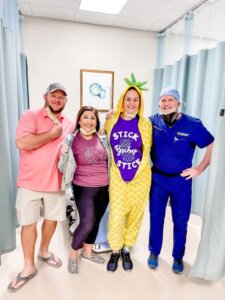
By February 2022, everything was in place to do another embryo transfer. This time around, Darra made a concerted effort to do everything she could to make her body more acceptable for implantation. She ate better, took prenatal vitamins religiously, and made sure she got a lot of sleep.
And she admits she got a little superstitious. “I kept seeing pineapples all over the place,” says Darra. “It was crazy, but it made me feel certain I was doing the right thing.” After realizing that pineapples were a sign of fertility, she knew the pineapple necklace she’d always worn had to have been a sign all along. Following the belief that pineapple core can aid in preparing a body for pregnancy, she ate it for the entire week before the transfer. Her large group of friends had pineapple-themed t-shirts made and texted her photos before she went in for the embryo transfer. And, then the transfer happened on 2/22/22, a superstitiously lucky day, so it had to be another sign, recalled Darra.
Feeling good about their preparations, the transfer went smoothly and now it was time to wait the obligatory two weeks before the pregnancy test. As the three were driving home to Lake Charles after Darra had her pregnancy blood test two weeks later at Fertility Answers Lafayette office, Stephanie got a call from Dr. Storment. “I knew it had to be good news, because the last time when it was negative he called later in the day. We were all screaming and crying driving west down I-10.” Darra was pregnant.
Finally bringing a baby home
Their gestational carrier story quickly gained notoriety in their Lake Charles community as Darra’s pregnancy began to show. People were intrigued by the fact that Darra was carrying a baby for her brother and sister-in-law. Some people even asked how she could give up the baby that she carried. But that didn’t bother her. “I had a job to do and that was to give my brother and Stephanie a baby. Everyone was so worried about me,” says Darra. “But I was fine. I was just the oven in this arrangement.”
Friends checked in on Darra constantly to make sure she was doing okay and to send funny photos when they spotted a pineapple. Even Darra’s obstetrician was excited about her pregnancy, as she was his first ever patient to be a gestational carrier. He even performed extra ultrasounds for Darra to give everyone peace of mind.
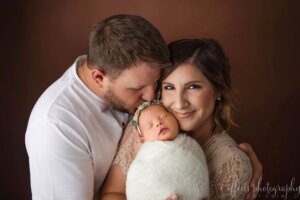
When Darra went into labor in late October, she was even a celebrity at the hospital, as she was the first gestational carrier to ever deliver at Lake Charles Memorial Hospital for Women. Darra labored all night, but her nurse stayed past her shift just to be able to witness and help in the delivery.
But the real star arrived later that morning. Baby Ruby was born with Stephanie and Drew in the delivery room to hold her immediately after birth. After two previous traumatic birth experiences, this time the delivery room was filled with tears of joy when Drew cut the cord of their healthy baby girl. “This was one of the few times I got really emotional and cried,” says Darra. “I was so overwhelmed knowing that Drew and Stephanie would be bringing this baby home from the hospital.”


